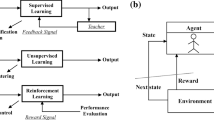Abstract
A hybrid control architecture combining behavior based reactive navigation and model based environment classification has been developed. It is also hybrid in the sense that both competitive coordination and cooperative coordination are used for the BBC (Behavior Based Control) part. The contributions are as follows. First, a Neural Network (NN) in charge of environment classification has been developed based on 16 prototypes of topological maps roughly describing various local navigation environments. This environment classification NN not only enables the navigator to avoid local minimum points but also eliminates the requirement for prior detailed modeling of the environment since it needs to memorize only “rough” information on local environments encountered along the way that might be sufficient for navigation. Next, an NN based reactive behavior controller will be trained to learn human steering commands for each of the 16 prototype local environments. Third, the modified potential field (MPF) method obtained by adding the free space vector as the third component is used to select a particular reactive behavior in conjunction with the classification NN. Finally, a hybrid control architecture integrating all three of these concepts was developed. It avoids local minimum traps as well as solves the problems of poor obstacle clearance or oscillation. It is robust against sensor noise and adaptive to dynamic environments. This hybrid architecture is also amenable to easy addition of new behaviors due to the modularity of the BBC architecture. The effectiveness of the proposed architecture has been verified through both computer simulation and an actual robot called MORIS (MObile Robot as an Intelligent System).
Similar content being viewed by others
References
Arkin, R.C. 1989. Motor-schema-based mobile robot navigation. International Journal of Robotics Research, 8(4):92–112.
Arkin, R.C. 1998. Behavior-based robotics. The MIT Press.
Barshan, B. and Ayrulu, B. 2000. Neural networks based target differentiation using sonar for robotics applications. In Proceedings of the 2000 IEEE International Conference on Robotics & Automation, San Francisco, CA, pp. 3745–3750.
Berlanga, A., Isasi, P., Sanchis, A., and Molina, J. 1999. Neural networks robot controller trained with evolution strategies. In Proceedings of Congress on Evolutionary Computation,Washington, DC, pp. 413–419.
Borenstein, J. and Koren, Y. 1989. Real-time obstacle avoidance for fast mobile robot. IEEE Transactions on Systems, Man, and Cybernetics, 19(5):1179–1187.
Borenstein, J. and Koren, Y. 1991. The vector field histogram—Fast obstacle avoidance for mobile robots. IEEE Journal of Robotics and Automation, 7(3):278–288.
Brooks, R.A. 1986. A robust layered control system for a mobile robot. IEEE Journal of Robotics and Automation, RA-2:14–23.
Brooks, R.A. 1996. Behavior-based humanoid robotics. In Proceedings of the 1996 lEEE/RSJ International Conference on Intelligent Robots and Systems'96, Osaka, Vol. 1, pp. 1–8.
Gomi, T. 1997. Subsumption robots and the aplication of intelligent robots to the service industry. Technical Paper, Applied AI Systems.
Im, K.Y., Oh, S.Y., and Han, S.J. 2002. Evolving a modular neural network-based behavioral fusion using extended VFF and environment classification for mobile robot navigation. IEEE Transactions on Evolutionary Computation, 6(4):413–419.
Khatib, O. 1985. Real-time obstacle avoidance for manipulators and mobile robots. In Proceedings of the 1985 IEEE International Conference on Robotics & Automation, St. Louis, MO, pp. 500–505.
Liu, C., Marcelo, H.A.J., Krishnan, H., and Ser-Yong, L. 2000. Virtual obstacle concept for local-minimum-recovery in potential-field based navigation. In Proceedings of the 2000 IEEE International Conference on Robotics & Automation, San Francisco, CA, Vol. 2, pp. 983–988
Maravall, D., de Lope, J., and Serradilla, F. 2000. Combination of model-based and reactive methods in autonomous navigation. In Proceedings of the 2000 IEEE Intern. Conf. Robotics & Automation, San Francisco, CA, pp. 977–982.
Moravec, H.P. and Elfes, A. 1985. High resolution maps from wide angle sonar. In Proceedings of the 1985 IEEE International Conference on Robotics & Automation, St. Louis, MO, pp. 116–121.
Prabir, K.P. and Asim, K. 1996. Mobile robot navigation using a neural net. In Proceedings of the 1996 IEEE International Conference on Robotics and Automation, Piscataway, NJ, pp. 1503–1508.
Ryu, B.S. and Yang, H.S. 1999. Integration of reactive behaviors and enhanced topological map for robust mobile robot navigation. IEEE Transaction on System, Man, and Cybernetics—part A, 29(5):474–485.
Rosenblatt, J.K. 1999. Optimal selection of uncertain actions by maximizing expected utility. CIRA'99, pp. 95–100.
Xiaowei, M., Xiaoli, L., Yulin, M., and Hegao, C. 1998. Real-time self-reaction of mobile robot with genetic fuzzy neural network in unknown environment. In Proceedings of the IEEE International Conference on Systems, Man, and Cybernetics, Vol. 4, pp. 3313–3318.
Xu, W.L. and Tso, S.K. 1999. Sensor-based fuzzy reactive navigation of a mobile robot through local target switching. IEEE Transactions on System, Man, and Cybernetics—part C. 29(3):451–459.
Yunfeng, W. and Gregory, S.C. 2000. A new potential field method for robot path planning. In Proceedings of the 2000 IEEE International Conference on Robotics & Automation, San Francisco, CA, pp. 977–982.
Zalzala, A.M.S. and Morris, A.S. 1996. Neural networks for robotic control. Ellis Horwood.
Author information
Authors and Affiliations
Rights and permissions
About this article
Cite this article
Na, YK., Oh, SY. Hybrid Control for Autonomous Mobile Robot Navigation Using Neural Network Based Behavior Modules and Environment Classification. Autonomous Robots 15, 193–206 (2003). https://doi.org/10.1023/A:1025597227189
Issue Date:
DOI: https://doi.org/10.1023/A:1025597227189




